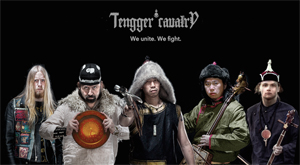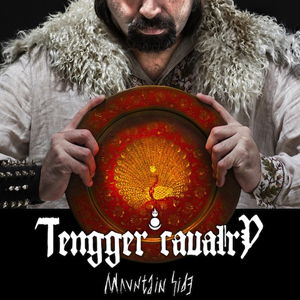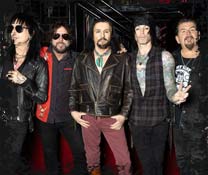In a world where nearly everything has been done, creating something truly original or unique seems virtually impossible. Nature Ganganbaigal has done just that, though. After spending his formative years in China playing in metal bands and then studying music and film composition in the U.S., he found a way to combine the music of the nomadic Mongolian people heíd encountered back home with the metal music heíd always loved. The resulting sound is decidedly unique. Itís heavy, melodic, has the mystique of being of the past, all while retaining a modern metal feel.
Since debuting as a solo performer in 2010, Ganganbaigal has gained global attention both as a composer and for his work with TENGGER CAVALRY. His new take on metal music has fans and critics alike taking notice. In 2015 Ganganbaigal added four members to TENGGER CAVALRY making it a complete band and released Mountain Side in 2016, an album featuring new material and a few previously released tracks as re-envisioned by the full band. With fresh material and a new live show TENGGER CAVALRY will be kicking off a U.S. tour mid-May.
I had a chance to chat with Nature Ganganbaigal about all things TENGGER CAVALRY. Hereís what he had to say.
KNAC.COM: Your style is very daring and unique, combining Mongolian folk music with metal. How did the concept originate?
GANGANBAIGAL: I was in a bunch of heavy metal bands while I was still living in China. Then, when I was in college, I had my own metal band, which was very traditional sounding. We did stuff in the same vein as IRON MAIDEN and JUDAS PRIEST. Eventually though, I got tired of making the same style of music that those great bands had already done. I started to explore different sounds and came up with the idea of combining Chinese Mongolian culture with metal.
I spent time researching different music looking for very ethnic sounds and found that I really connected with albums featuring Mongolian acoustic fiddle. I guess because of my Mongolian ancestry, it always clicked with me even as far back as when I was in high school. After the traditional metal band I wanted to create something different and more interesting, something that belonged to my own culture. That was the initial idea, to develop a new sound that combined heavy metal with the traditional music of my region.
 KNAC.COM: TENGGER CAVALRYís sound has kind of a layering feel to it. There are underlying rhythms with instrumental melodies and vocals layered overtop or interwoven throughout the songs. During songwriting are the rhythms laid out first or do the melodies take precedence?
KNAC.COM: TENGGER CAVALRYís sound has kind of a layering feel to it. There are underlying rhythms with instrumental melodies and vocals layered overtop or interwoven throughout the songs. During songwriting are the rhythms laid out first or do the melodies take precedence?
GANGANBAIGAL: I studied film and music composition at New York University, so my songwriting tends to combine layers and textures. In composition they talk a lot about textures, so thatís the way I think about music during the writing process. I start with a good guitar riff because I have a metal background and Iím used to the groove driving the music. The riff always provides the inspiration for a songís idea. Then the melody develops over top of that. It would be weird for me to write a melody first, and then try to find a riff that fits it.
Normal pop music is just chord, chord, chord, because thatís what you do. When you have a good melody you can try to write a good chord to go with it, but that sounds boring to me. When I write, the riff and groove come first and the melody second.
KNAC.COM: Since the release then re-release of the album Blood Sacrifice Shaman, in 2010 and 2015 respectively, youíve steadily gained recognition first internationally and now here in the States. Was there an immediate positive response in your home country of China before the rest of the world caught on to what you were all about?
GANGANBAIGAL: The band was more well recognized and well received after coming into the European and American markets. There are more opportunities to create art that you like here regardless of different ideologies, politics or whatever. You can write about anything you want here in the United States. We try not to exaggerate the politics part too much, but we do have a message that we want to get across through our music.
KNAC.COM: The bandís sound features a lyrical style called Khoomei or throat singing. Please elaborate on how this is done and how the effect presents musically.
GANGANBAIGAL: Throat singing is a method of overtone singing. You compress the chest or a specific part of the throat and sing a drone that forms the basic, fundamental note. Then you use the mouth, tongue and even resonate the nasal passage to create an overtone on top of the drone. There are perhaps 20 different variations of throat singing, but I only know a few of them. Iím still learning the style. Thatís the basic idea, though.
KNAC.COM: Do you find it more difficult to articulate lyrics given how tightly your mouth must be formed and controlled while throat singing?
GANGANBAIGAL: Yes, definitely. Our new song ďMountain SideĒ uses throat singing, but itís sung completely in English. I intend to write more songs in English, but itís very different because of the pronunciations. In English itís hard to sing specific notes or overtones because I have to more fully open my mouth for the pronunciations of certain words. Doing so can decrease the overtones of surrounding notes, so I have to either change melodies or find different lyrics that have the same meaning.
I want to make sure people can hear the texture of my throat singing more than just the lyrics. As a songwriter, the lyrics arenít as important to me as the emotions they convey.
KNAC.COM: What are some of the nomadic Mongolian instruments featured in your music and on your latest release Mountain Side?
GANGANBAIGAL: The main folk instrument we use is the Mongolian horsehead fiddle (morin khuur). Itís similar to a cello, but with two strings and a horsehead on its headstock. Itís a very traditional Mongolian melodic instrument. I use it to present song choruses or fast, galloping style grooves. Another instrument I use is the dombra, which is like a two-string guitar. Itís not from Mongolia, but rather a nomadic folk instrument from Kazakhstan. Iím lucky enough to have a very good friend who makes them, so I learned how to play it and really fell in love with it. Itís a bit easier to play than the morin khuur and itís great for recreating the sound of horses being ridden very quickly. Itís definitely one of my top two favorite instruments.
 I also use the jaw harp, a little piece of metal placed in the front of the mouth to generate overtone sounds. We use it to decorate some parts of the music. Sometimes weíll use the shaman frame drum. Itís not specific to Mongolia or Central Asia. All of the Celtic, Viking and shamanic people share it in common. It has a very tribal sound emitting low tones and vibrations.
I also use the jaw harp, a little piece of metal placed in the front of the mouth to generate overtone sounds. We use it to decorate some parts of the music. Sometimes weíll use the shaman frame drum. Itís not specific to Mongolia or Central Asia. All of the Celtic, Viking and shamanic people share it in common. It has a very tribal sound emitting low tones and vibrations.
KNAC.COM: Itís clear that tradition is of great importance to you and in your music. Does the incorporation of nomadic Mongolian instruments and singing styles help make people around the world more aware of a culture they may otherwise not have discovered?
GANGANBAIGAL: Oh yeah! It really helps the developing Asian and nomadic cultures. Iím not exaggerating when I say that a lot people have come to us and said that they are fascinated by the Central Asian, nomadic and Mongolian stories. Theyíd never heard about it before our music, but are now very interested in it. Weíve had the chance to use the international sound to create exposure for our regionís culture, an outcome of doing this about which I am definitely pleased.
As important as tradition is, though, I live in the 21st century. Iím not one dimensionally focused on things of the past. I live in New York City. We combine traditional and modern music, trying to find a balance between them. We want to communicate our tradition but in a very modern way.
KNAC.COM: When you brought Robert McLaughlin into the band, were you surprised to find someone of Western descent with a full understanding of the Eastern Tuva tradition?
GANGANBAIGAL: Robert is an amazing guy. Heís from the U.S., but he not only plays the music, he also speaks the native language. Heís a practicing shaman, too. I guess thatís why Iíve developed the mentality that deep tradition exists inside each one of us. Even though we identify with modern times, we all have roots in tribal culture. This sound has a way of waking up the tradition within us. Itís cool to work with someone like Robert because I want to learn as much as possible about differing cultures.
KNAC.COM: Your 2016 release Mountain Side is a blend of new and previously released material with a few remixes, as well. What was your overall vision heading into the studio now having a full band?
GANGANBAIGAL: Previously, I wrote all of the material and was a solo artist. Now that we have a bunch of really talented people in the band, everyone is involved in the songwriting. I write down the basic structure, and then we all sit down and jam together like folk musicians. Thatís how we wrote ďMountain SideĒ. We were jamming with our drummer, Josh Schifris. He started playing an AC/DC style drumbeat over which I began playing a very old-school guitar riff. We created parts as we jammed to it, so all that remained was to write a chorus.
Each member of the band is now contributing more and more to the music. Then I put it all together, produce and orchestrate it. Thatís our new songwriting process and we all really enjoy it. Itís a collaborative effort, but Iíll make sure that we retain the TENGGER CAVALRY sound. Itís about combining everyoneís best ideas into the music.
KNAC.COM: Was there a big metal scene where you grew up in China or was it something you had to really seek out?
GANGANBAIGAL: There wasnít a very good metal scene when I was growing up in China. I remember when I was 11 or 12 and TESTAMENT first toured America. It was such a historical event for the whole metal scene. By now, METALLICA and MEGADETH have played Shanghai, so the Chinese government has become more supportive of the music over time. They recognize that thereís profit to be made from it and they donít see it so much as an anti-government thing anymore. The metal scene is booming in China these days.
 When I was a kid metal wasnít accepted at all and parents were definitely against it. Kids in the Western world got backlash from their parents for being into metal, but the intensity was far greater growing up in China. You had to really seek it out and have tons of fights with your parents. It didnít make sense to them because there was no market for metal music in China at that time. It was difficult to convince them that there was a future or career to build pursuing that style of music. It wasnít like the U.S. where you had PR, distribution and music video teams. Back then no one where I grew up really knew what to do in order to be successful.
When I was a kid metal wasnít accepted at all and parents were definitely against it. Kids in the Western world got backlash from their parents for being into metal, but the intensity was far greater growing up in China. You had to really seek it out and have tons of fights with your parents. It didnít make sense to them because there was no market for metal music in China at that time. It was difficult to convince them that there was a future or career to build pursuing that style of music. It wasnít like the U.S. where you had PR, distribution and music video teams. Back then no one where I grew up really knew what to do in order to be successful.
KNAC.COM: As TENGGER CAVALRY heads out on its U.S. tour what are some of the challenges of recreating the music live given the wide array of instruments used?
GANGANBAIGAL: We have a lot of fun because we use a lot of space. Weíre not just a metal band. We also fit the mold of a folk band because we sometimes jam around old material while other times follow closer to the original songs. Folk players arenít classical musicians. They donít play according to the score. You play differently every time and different music at every show. We might change a melody around depending on the mood of the musicians. Thatís one of the things I really like about TENNGER CAVALRY. We incorporate the folk or world musician mentality into heavy metal music.
KNAC.COM: So TENNGER CAVALRYís fans are guaranteed to see a different show every time?
GANGANBAIGAL: Yeah! Weíve actually played the same venue several times here in New York, but we still see the same fans. We see new fans, too, of course. At every show we dress differently and play differently because we know if fans see the same material over and over again, theyíll become disinterested. You want to create something new each time. We certainly have the ability to recreate our original material in a live setting, but when fans spend their time and money to come to a gig, they want to see something different.
KNAC.COM: You won a Global Music Award for your 2014 release To Where Tengger Leads Me and also received a Hollywood Music in Media nomination among other accolades for your work. Do you feel as though these bring mainstream validation to the chance you took to do something very different?
GANGANBAIGAL: Absolutely! When the academic world approves of what youíre doing and give you awards, it means they like what youíre doing, too. Itís very cool that the fans dig it, but itís also great getting that academic recognition.
More than anything I want the fans to know that I appreciate all of their support and hope theyíre able to make it out to one of our shows on the North American tour. Weíve worked really hard on it and are bringing a lot of decorations and new songs to the stage.
Every now and then you come across a band that isnít just more of the same. They put out material that sticks with you. TENGGER CAVALRY is one of those bands. They have a sound all their own. You find yourself wanting to discover the backstory behind them and delving further into the culture behind the bandís music. TENGGER CAVALRY masterfully blends old and new, combining the mysteries of long-held tradition with kick ass metal.




